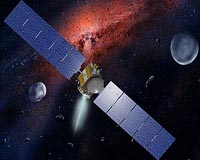 |
Tokyo, Japan (SPX) Nov 23, 2009 The Japan Aerospace Exploration Agency (JAXA) has been studying measures to deal with the anomaly detected in one of the ion engines aboard the Asteroid Explorer "HAYABUSA" as reported on November 9, 2009. As a result, the project team has come up with a recovery operation plan, and the project decided to resume the operations, while carefully watching the status of the ion engines. JAXA has been studying the characteristics of the neutralizers and the ion sources. During the study, enough thrust is found available for the rest of the cruise, when the neutralizer of the engine-A is combined with the ion source of the engine-B. While the operation still needs monitored carefully, the project team has concluded the spacecraft can maintain the current return cruise schedule back to the earth around June of 2010, if the new engines configuration continues to work as planned. The project team will attentively monitor the return cruise, and JAXA will inform you of any update whenever available. Share This Article With Planet Earth
Related Links Japan Aerospace Exploration Agency (JAXA) Asteroid and Comet Mission News, Science and Technology
 Dawn Enters Asteroid Belt - For Good
Dawn Enters Asteroid Belt - For GoodPasadena CA (SPX) Nov 16, 2009 NASA's Dawn spacecraft re-entered our solar system's asteroid belt on Nov. 13, and this time it will stay there. Dawn first entered the belt (whose lower boundary may be defined as the greatest distance Mars gets from the sun (249,230,000 kilometers, or 154,864,000 miles) in June 2008. It remained within the belt for 40 days before its carefully planned orbital path brought it below the as ... read more |
|
| The content herein, unless otherwise known to be public domain, are Copyright 1995-2009 - SpaceDaily. AFP and UPI Wire Stories are copyright Agence France-Presse and United Press International. ESA Portal Reports are copyright European Space Agency. All NASA sourced material is public domain. Additional copyrights may apply in whole or part to other bona fide parties. Advertising does not imply endorsement,agreement or approval of any opinions, statements or information provided by SpaceDaily on any Web page published or hosted by SpaceDaily. Privacy Statement |